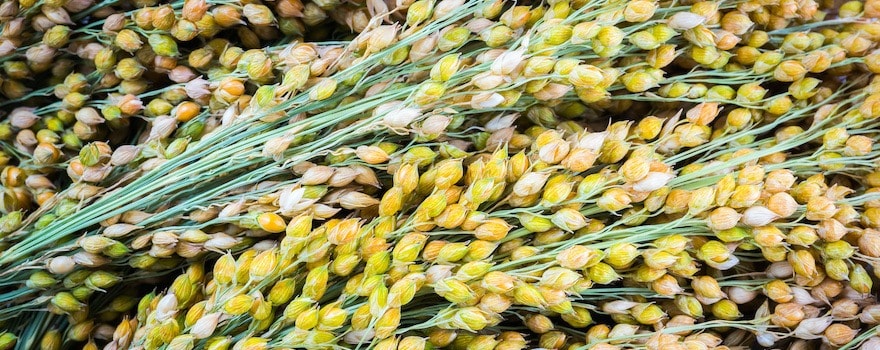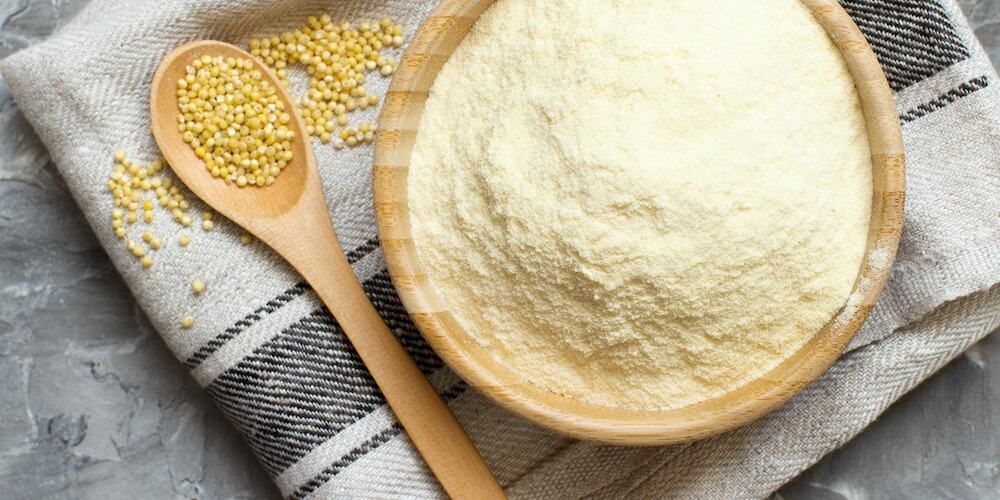The benefits of millet flour
Millet flour: what is it?
Millet is an ancient cereal native to Africa and Asia. Like sorghum or oats, it belongs to the grass family.
There are different varieties, but it is pearl millet (Pennisetum glaucum) that is most commonly used for flour production. The plant produces small, yellow, edible seeds.
Once harvested, they are hulled and then ground. The result is a flour with an off-white color and, most importantly, gluten-free.
Indeed, like buckwheat or hemp flour, it is gluten-free. It is therefore ideal for people with celiac disease. Another advantage: it is nutritious, rich in plant proteins and minerals.
Finally, people appreciate its hazelnut notes and the many ways it can be used in cooking.
Benefits of millet seeds
With about 11 g per 100 g, these seeds are an excellent source of plant-based proteins. They contain essential amino acids: isoleucine, leucine, methionine and also tryptophan. Thus, they can help compensate for deficiencies caused by a flexitarian, vegetarian, or vegan diet.
They also contain fiber and various minerals and trace elements. They are rich in phosphorus, calcium, iron and zinc. Finally, they provide a large number of B-group vitamins as well as vitamins E and K.
Today, millet seeds are recognized for their antioxidant properties. As shown by this study, they also improve diabetes and help with weight loss.

How to choose your millet flour?
Golden millet flour, brown millet flour or pearl millet flour: which should you choose?
There are different varieties of millet flour. For instance, you can distinguish flour made from :
- millet brun : il est la forme « sauvage » du millet doré. Il n’a pas besoin d’être débarrassé de son enveloppe. C’est le plus digeste et le plus nutritif ;
- millet doré : il est nécessaire de le décortiquer pour le rendre digeste. Il est donc moins nutritif que le millet brun ;
- millet perlé : aussi appelé « petit mil », il est particulièrement riche en fer. Mais ce type de farine est moins facile à trouver.
Other quality criteria
We recommend choosing an organic millet flour. This will help you avoid residues of chemicals and pesticides in the final product. It should also be 100 % natural, without additives and without preservatives.
If you can, choose millet from France. Although it is still little cultivated, there are producers in the southwest (Poitou-Charentes, Gers…) and the Pays de la Loire. Support local supply chains as much as possible.
Also opt for a flour milled on a stone mill. It has a finer texture and has retained all its nutrients.
Finally, like sorghum, amaranth and quinoa, millet is prone to cross-contamination. Therefore, the flour may contain traces of gluten. Check this information on the packaging if you need to follow a strict gluten-free diet.
How to use millet flour?
In cooking
In cooking, it is prized for its hazelnut notes. But its flavor is quite pronounced and distinctive. You can soften it by combining it with a milder flour such as rice flour or tiger nut flour. In that case, it should make up 30 % of the mixture.
Millet flour can be used to make many sweet recipes : breads, crêpes, waffles, cakes… It is also useful in savory dishes : loaves, vegetarian patties, pizza dough… It gives a texture similar to wheat flour.
Be sure to store it properly as it is prone to rancidity. Ideally keep it in the refrigerator after opening. Its shelf life is about 6 months.

Homemade millet and tigernut spread
This recipe reinvents the traditional spread. You can enjoy it on toast… or straight from a teaspoon !
To make this recipe, gather:
- 50 g de farine de millet
- 50 g de farine de souchet
- 1 à 2 cuillères à soupe d’huile végétale
- 160 g de miel
In a bowl, add all the ingredients and mix until you have a smooth, uniform mixture.
Pour the mixture into a small glass jar.
Store your spread in the refrigerator and consume it quickly.
Gluten-free millet waffles
This flour is ideal for making gluten-free waffles. It gives them a hazelnut flavor, a light, crispy texture.
To make this recipe, gather:
- 100 g de farine de millet
- 100 g de farine de riz
- 2 œufs
- 40 g de beurre
- 2 cuillères à café de sucre
- 1/3 de sachet de sucre vanillé
- 20 cl de lait
- 10 cl d’eau
Start by melting the butter in a saucepan over low heat.
Meanwhile, pour the flours into a bowl and mix. Gradually add the milk and mix again until you have a smooth mixture. Finally, add the egg yolks and set the whites aside.
In your mixture, add the sugars, water, and melted butter. Mix.
Whip the egg whites until stiff and gently fold them into the previous mixture.
Your waffle batter is ready !



